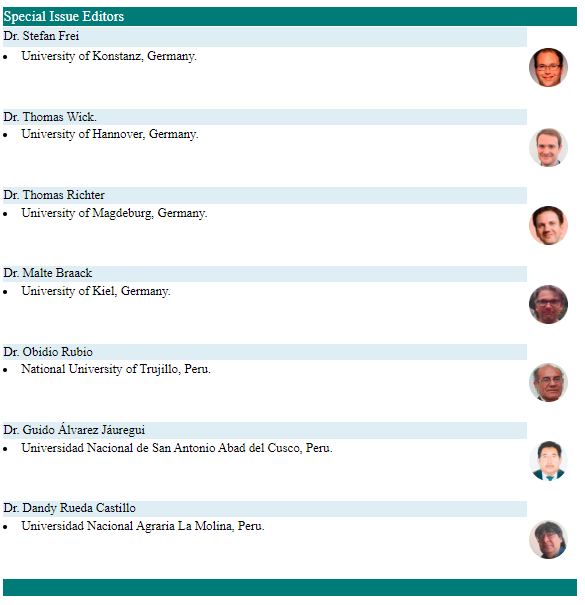Validation of simulated precipitation forecasts with the BRAMS model for the La Libertad-Peru region
DOI:
https://doi.org/10.17268/sel.mat.2021.01.15Keywords:
Numerical model BRAMS, quality evaluation, forecast verification, precipitationAbstract
The objective of this work is to validate the precipitation forecasts simulated with the Brazilian Regional Atmospheric Modelling Systems (BRAMS) numerical model in its version 5.3, for the La Libertad Region in Peru; this region of Peru has 80% of its land located in the northern highlands of Peru. In mountainous areas, precipitation is strongly influenced by the height of the terrain, a poor representation of the topographic elevations and depressions of the terrain can lead to an erroneous representation of the resolvable phenomena explicit by the model. Taking into account this characteristic of the study area, in the first instance the BRAMS model was configured to adequately represent the rugged orography of the local área at a horizontal resolution of 10 km. Then, the model was run to simulate precipitation forecasts at time horizons of 24, 48, 72, 96 and 120 hours, for the months of December 2019, January and February 2020.
The validation of the forecasts was performed against observed data obtained from the National Meteorological and Hydrological Service (SENAMHI) of Peru, using quality indices for continuous and binary variables. From the results obtained, it is concluded that the BRAMS model performed well in forecasting the occurrence of precipitation for all time horizons. However, the model had difficulties in forecasting the occurrence of precipitation for higher thresholds, and predicted more false alarms for these thresholds.
Finally, the model applied to the La Libertad Region in Peru, with a fairly rugged topography, had similar results to those obtained by other regional models applied in areas where there is little influence of terrain height.
References
Coello C, Brow B, Wilson L, Mittemaier B, Casati B. Forecats verification for S2S timescales. Elsevier Inc. 2019; 29(1), 11-21.
Dillon M, Skabar Y, Nicolini M. Desempeño del pronóstico de modelos de alta resolución, en un área limitada: análisis de la estación de verano 2010-2011. Meteorológica. 2013; 38:69-89.
Freitas S, Panetta J, Longo K, Rodrigues L, Moreira D, Rosario N, y otros. The Brazilian developments on the Regional Atmospheric Modeling. Geosci. Model Dev. 2017; 189-222.
García Y, Salio P, Nicolini M. Verificación de los pronósticos del modelo BRAMS centrado en la región subtropical de Sudámerica. Meteorología. 2012; 27(3).
Iacono MJ, Delamere JS, Mlawer EJ, Shephard MW, Clough SA and Collins WD. Radiative forcing by long-lived greenhouse gases: Calculations with the AER radiative transfer models. J. Geophys. Res. 2008; 113:D13103. doi:10.1029/2008JD009944.
Jolline I. Forecast verification. A practitioner’s Guide in Atmospheric Science. England: Jhon Wiley & Sons inc. 2003.
Matsudo C, García Y, Ferreiral JR, Salio P, Vidal L, Nicolini M. Sistema de pronóstico experimental en alta resolución con el modelo BRAMS. Meteorológica. 2012; 38(1):53-38.
Maussion FS. WRF simulation of a precipitation event over the Tibetan Plateau, China - An assessment using remote sensing and ground observations. Hydrology and Earth System Sciences, 201 1;15(6), 1795-1817.
Mellor GL and Yamada T. Development of a turbulence closure model for geophysical fluid problems. Rev. Geophys. Space Phys. 1982; 20:851–875. doi:10.1029/RG020i004p00851.
Rubio O, Caucha L, Campos Velho H. Simulación Meteorológica a Nivel Mesoescala del Norte de Perú(2015) usando Brazilian
Regional Atmospheric Modelling System (BRAMS). Selecciones Matemáticas. 2015; 2(02):68-75.
Rubio O, Zavaleta J, Carranza A. Sobre la Existencia de Soluciones para un Modelo de Precipitaciones Atmosférica. Selecciones
Matemáticas. 2015; 2(01):32-44.
Santos de Oliveira SS, Pereira de Souza EP. Análise de modelos de mesoescala para caracterizacao do potencial eolico do estado da Paraíba. Revista Brasileira de Meteorologia. 2017; 32(2), 277–291.
Saulo CS, Cardazzo J, Ruiz C, Campetella y Rolla A. El sistema de pronóstico experimental del Centro de Investigaciones del Mar y la Atmósfera. Meteorológica. 2008; 33:83-97.
Thompson G and Eidhammer T. A study of aerosol impacts on clouds and precipitation development in a large winter cyclone. J. Atmos. Sci. 2014; 71:3636–3658. doi:10.1175/JAS-D-13-0305.
Tremback C, Powell J, Cotton W and Pielke R. The forward- in-time upstream advection scheme: Extension to higher orders. Mon. Weather Rev. 1987; 115:540–555.
Tripoli GJ and Cotton WR. The Colorado State University three-dimensional cloud/mesoscale model. Part I: General theoretical
framework and sensitivity experiments. J. Rech. Atmos. 1982; 16:185–220.
Wilks DS. Statistical Methods in the Atmospheric Sciences. Second Edition ed. San Diego, California, USA: Elseiver Inc. 2006.
Williams PD. A proposed modification to the Robert-Asselin time filter. Mon. Weather Rev. 2009; 137:2538–2546.
Downloads
Published
How to Cite
Issue
Section
License
Copyright (c) 2021 Martha Nina, Obidio Rubio

This work is licensed under a Creative Commons Attribution 4.0 International License.
The authors who publish in this journal accept the following conditions:
1. The authors retain the copyright and assign to the journal the right of the first publication, with the work registered with the Creative Commons Attribution License,Atribución 4.0 Internacional (CC BY 4.0) which allows third parties to use what is published whenever they mention the authorship of the work And to the first publication in this magazine.
2. Authors may make other independent and additional contractual arrangements for non-exclusive distribution of the version of the article published in this journal (eg, include it in an institutional repository or publish it in a book) provided they clearly state that The paper was first published in this journal.
3. Authors are encouraged to publish their work on the Internet (for example, on institutional or personal pages) before and during the review and publication process, as it can lead to productive exchanges and to a greater and more rapid dissemination Of the published work.












